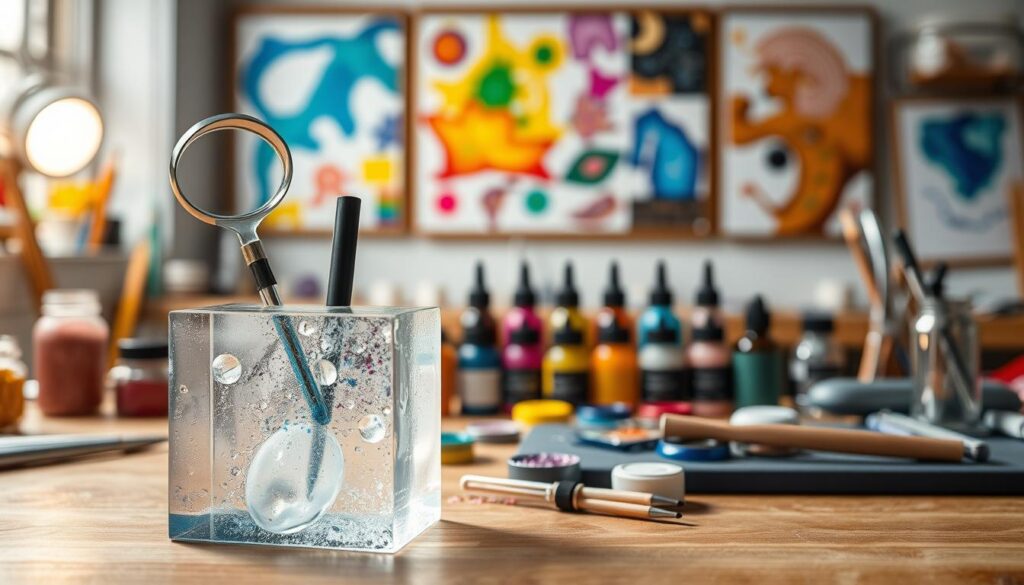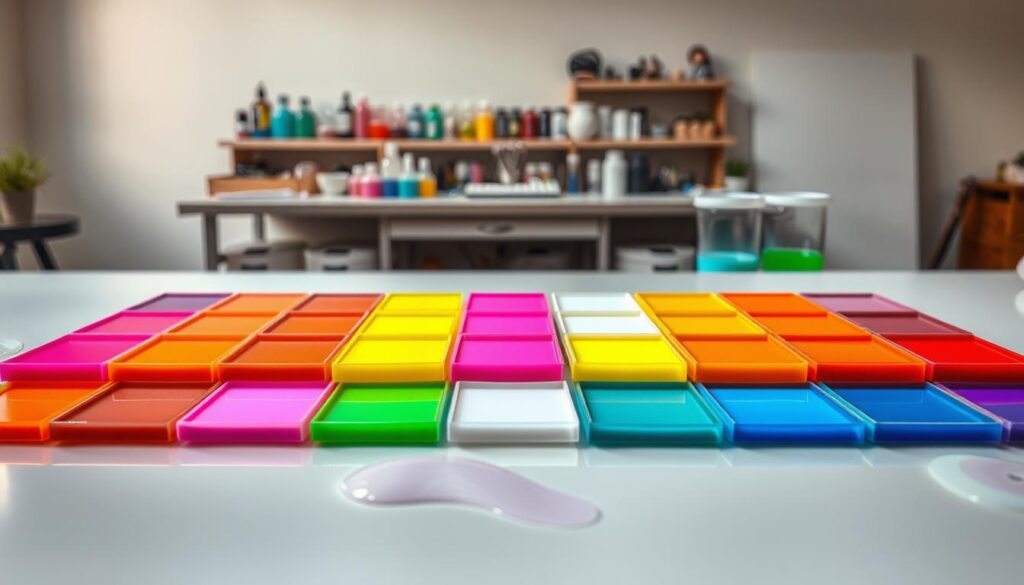Diving into DIY art has never been easier—or more rewarding. With just a few materials, you can create stunning pieces that look professionally designed. The secret? A versatile material that starts as a liquid and hardens into a glossy, durable finish.
This creative medium is perfect for first-timers. You don’t need advanced skills to make jewelry trays, coasters, or decorative items. Brands like ArtResin offer easy-to-use kits, while online tutorials break down every step. Best of all, mistakes often turn into happy accidents!
Want to personalize your space or gift something unique? Mix colors, add dried flowers, or embed small trinkets. Once you master pouring and curing, the possibilities explode. Your style shines through every piece, whether it’s bohemian, modern, or totally quirky.
Ready to start? Grab gloves, silicone molds, and your imagination. We’ll guide you through simple projects that build confidence—no fancy studio required. Let’s turn that curiosity into something you can hold in your hands!
Key Takeaways
- Beginner-friendly projects require minimal supplies and basic techniques.
- Epoxy resin transforms from liquid to solid, creating glossy, custom designs.
- Experiment with colors, textures, and embedded objects for unique results.
- Trusted brands like ArtResin provide reliable materials for safety and quality.
- Online tutorials offer step-by-step guidance for mastering foundational skills.
Introduction to Resin Crafts
Discover how liquid magic transforms everyday items into dazzling decor. This art form lets DIY enthusiasts turn basic supplies into glossy, personalized pieces. From jewelry trays to wall art, the options are endless—and forgiving for newcomers.
Why do creators love it? Epoxy blends flexibility with durability, letting you experiment without pressure. Spill some pigment? It becomes abstract flair. Forget perfect measurements? Now it’s a one-of-a-kind pattern. Projects like coasters or seasonal decorations show how versatile this medium is.
| Project Type | Materials Needed | Finished Look |
|---|---|---|
| Coasters | Silicone molds, pigments | Vibrant, waterproof surfaces |
| Tea Light Holders | Glass jars, glitter | Glowing centerpieces |
| Wall Hangings | Wood slices, dried flowers | Nature-inspired accents |
New to crafting? Start small. Mix colors in disposable cups, pour into molds, and watch your vision solidify. Within hours, you’ll have functional art that elevates your home or makes heartfelt gifts. The best part? Every “oops” moment adds character.
Ready to try? Grab a starter kit and let curiosity lead. Your first piece might just become your new obsession!
What is Resin and How Does It Work?
Unlocking the secrets of epoxy starts with understanding its chemistry. When combined, two liquid components—epoxy resin and hardener—trigger an exothermic reaction. This process transforms them into a solid, glass-like material perfect for creative projects.
Components of Resin and Hardener
The magic happens when you mix equal parts resin and hardener (often a 1:1 ratio). Each bottle contains unique chemicals that, when blended, create cross-linked molecular bonds. Measure carefully—too much hardener causes brittleness, while insufficient amounts leave sticky residues.
Art Resin Versus Casting Resin
Not all epoxies are created equal. Here’s the breakdown:
| Type | Best For | Curing Time |
|---|---|---|
| Art Resin | Thin layers (coasters, paintings) | 24-48 hours |
| Casting Resin | Thick pours (paperweights, molds) | 72+ hours |
Beginners love art resin for its foolproof mixing and minimal bubbles. Brands like ArtResin simplify the process with pre-measured kits. As one crafter notes: “Follow the instructions—your safety goggles aren’t just a fashion statement!”
For detailed mixing ratios and troubleshooting, check trusted guides. Remember: precise measurements ensure crystal-clear results that withstand daily use.
Essential Tools and Materials for Resin Projects
Starting your creative journey requires the right tools to bring ideas to life. Whether you’re making coasters or decorative pieces, having reliable supplies ensures smooth results and fewer frustrations.
Must-Have Supplies for Beginners
Begin with these basics:
- Epoxy kits: Pre-measured formulas reduce guesswork
- Disposable cups: Perfect for mixing without residue
- Silicone mats: Protect surfaces and simplify cleanup
Quality matters. Thin plastic cups can warp during mixing, while sturdy silicone molds release hardened items effortlessly. One DIYer shares: “A heat gun eliminated my bubble struggles—worth every penny!”
Optional Embellishments and Accessories
Once you’ve mastered basics, add flair:
- Mica powders for metallic shimmer
- Dried botanicals for organic textures
- Glitter or sequins for playful accents
Specialty mold shapes—like geometric trays or pendant forms—let you experiment with new styles. Start small: repurpose household items like cookie cutters as budget-friendly alternatives.
Remember: proper ventilation and gloves aren’t optional. As your confidence grows, so can your toolkit. Happy creating!
Step-by-Step Guide to Your First Resin Project
Let’s dive into the hands-on process of making your debut piece. With careful preparation and simple techniques, you’ll create a polished result that feels both professional and personal.
Preparing Your Workspace and Safety Gear
Choose a well-ventilated area away from pets and food. Cover surfaces with silicone mats or wax paper. Safety essentials include:
- Nitrile gloves to protect skin
- Safety goggles against splashes
- A respirator mask if working indoors
Wipe down your space with a microfiber cloth to eliminate dust. Even tiny particles can stick to your piece!
Mixing, Pouring, and Curing Techniques
Measure equal parts resin and hardener using graduated cups. Stir slowly for 3-5 minutes—scrape the sides to ensure thorough blending. “Rushing this step creates stubborn bubbles,” notes DIY instructor Marla Chen.
Pour the mixture into molds in thin layers. Pass a heat gun 6″ above the surface to pop air pockets. Let cure undisturbed for 24 hours. Resist poking it—partial hardening ruins the finish!
| Stage | Time Needed | Pro Tip |
|---|---|---|
| Mixing | 5 minutes | Use wooden sticks for smoother blending |
| Curing | 1 day | Cover with a box to prevent dust |
Creative Ideas for Resin Crafts
Turn everyday materials into showstopping pieces that blend function with artistry. These beginner-friendly concepts let you explore textures, hues, and forms—perfect for gifting or jazzing up your space.
DIY Coasters and Tea Light Holders
Silicone molds make coaster creation a breeze. Pour clear epoxy mixed with alcohol ink, then swirl with a toothpick for marble effects. Add glitter or pressed flowers before the mixture sets. For tea lights, layer translucent colors in glass containers. They’ll cast dreamy glows during dinners!
| Project | Materials | Drying Time |
|---|---|---|
| Coasters | Mold, ink, mixing sticks | 24 hours |
| Tea Lights | Glass jars, glow powder | 48 hours |
Unique Jewelry and Pendants
Design wearable art using pendant molds. Mix opaque and transparent pigments for depth, then embed tiny charms. As jewelry maker Lila Torres advises: “Sand edges gently after curing for a professional finish.” Try metallic leaf accents or iridescent flakes for boho-chic vibes.
Experiment with layered pours—pour one color, let it half-set, then add another. This technique creates striking dimensional effects in earrings or statement necklaces. Whether you prefer subtle neutrals or rainbow bursts, your personality shines through every piece!
Troubleshooting Common Resin Crafting Issues

Even the most exciting projects can hit snags. Tiny bubbles or sticky finishes don’t mean failure—they’re just part of the learning curve. Let’s tackle these hurdles so you can create flawless pieces every time.
Managing Air Bubbles and Achieving Clarity
Those pesky bubbles often appear when mixing too quickly. Stir slowly in a zigzag pattern to minimize air traps. For stubborn pockets, gently wave a heat gun 6″ above the surface. “A quick pass with a lighter works too—just don’t linger!” advises artisan Jamie Rivera.
Thicker pours need extra care. Pour in thin layers, letting each cure halfway before adding more. This method reduces bubble formation and ensures crystal-clear results for jewelry displays or decorative trays.
Optimal Curing Conditions and Temperature Tips
Your environment plays a huge role. Aim for 70-75°F with 50% humidity for smooth hardening. Cold spaces slow curing, while heat accelerates it—both can cause cracks or cloudiness. Keep pieces covered with a cardboard box to block dust.
| Condition | Ideal | Avoid |
|---|---|---|
| Temperature | Room temp (70°F) | Below 65°F or above 85°F |
| Humidity | 40-60% | Over 70% |
| Surface | Level & stable | Uneven or vibrating |
Material choice matters. Use deep-pour formulas for bulky molds and quick-set options for small projects. Our detailed troubleshooting guide helps match products to your goals. Remember: patience transforms frustration into flawless finishes!
Safety Tips and Best Practices for Resin Projects
Creating with epoxy is exciting, but safety keeps the fun going. While vibrant pigments and glossy finishes steal the spotlight, protective measures ensure your projects stay enjoyable and risk-free. Let’s explore how simple precautions can safeguard your health while you design stunning pieces.
Essential Protective Equipment
Always wear nitrile gloves—latex won’t block harmful chemicals. Safety goggles shield eyes from accidental splashes, and a respirator mask filters fumes during mixing. ArtResin’s Safety Data Sheet emphasizes: “Skin contact with uncured epoxy may cause irritation—never skip protection.”
Proper Ventilation and Handling Techniques
Work near open windows or use fans to circulate fresh air. Epoxy releases volatile compounds as it cures, especially during the first 12 hours. Avoid eating in your workspace, and store materials away from children or pets.
| Ventilation Method | Effectiveness | Best For |
|---|---|---|
| Open Window | High | Small batches |
| Air Purifier | Moderate | Indoor spaces |
| Portable Fan | Low | Quick fixes |
Clean spills immediately with isopropyl alcohol, and dispose of mixing tools properly. Follow your epoxy brand’s curing timeline—rushing the process weakens durability. Remember: prioritizing safety lets creativity flourish without compromises!
Customizing Your Resin Crafts with Colors and Embellishments
Personalize your projects with vibrant shades and sparkling accents that pop. Whether you’re designing coasters or pendants, strategic color choices and creative add-ins turn basic items into conversation starters. Let’s explore how to blend pigments and textures for showstopping results.

Exploring Color Mixing Techniques
Start with primary colors to create custom hues. Mix blue and yellow resin dyes for earthy greens, or blend red and white for soft pinks. Alcohol inks offer translucent layers—perfect for galaxy-inspired designs. For marbled effects, swirl pigments with a toothpick before pouring.
Want to preserve memories? Seal printed pictures between epoxy layers. Laminate photos first to prevent ink bleeding. One artist shares: “Grandma’s recipe card embedded in a tray became my favorite kitchen piece!”
| Color Combo | Effect | Best For |
|---|---|---|
| Gold + Clear | Metallic accents | Jewelry dishes |
| Pastels + White | Soft watercolor | Nursery decor |
Enhancing Designs with Glitter, Mica, and Flowers
Add dimension with chunky glitter for disco-ball vibes or fine mica powder for subtle shimmer. Press dried flowers face-down into wet epoxy to preserve their delicate shapes. For layered pendants, sprinkle gold flakes between cured layers.
Try these combinations:
- Glitter gradients: Dark-to-light sequins in sunset hues
- Mica-dusted leaves: Brush powder onto botanicals before embedding
- Flower collages: Arrange petals to tell visual stories
Pro tip: Use UV-resistant sprays when including pictures or natural elements. Your creations will stay vibrant for years, just like your creativity!
Conclusion
Your creative journey with epoxy transforms imagination into tangible art. From selecting the right materials to mastering pouring techniques, every step builds confidence. Remember: quality tools and safety gear turn frustrations into triumphs.
Experiment freely—try geometric mold shapes or layered color effects. Those first wobbly coasters? They’re stepping stones to gallery-worthy pieces. Whether designing home accents or statement jewelry, each creation reflects your unique style.
Keep these takeaways close: measure epoxy precisely, cure in ideal conditions, and embrace imperfections as design features. Every project teaches something new—like how glitter catches light differently in thin versus thick pours.
Ready for more? Swap tips with online communities or challenge friends to a crafting night. With practice, you’ll turn simple supplies into heirlooms. Now go make something that dazzles—your next masterpiece awaits!

